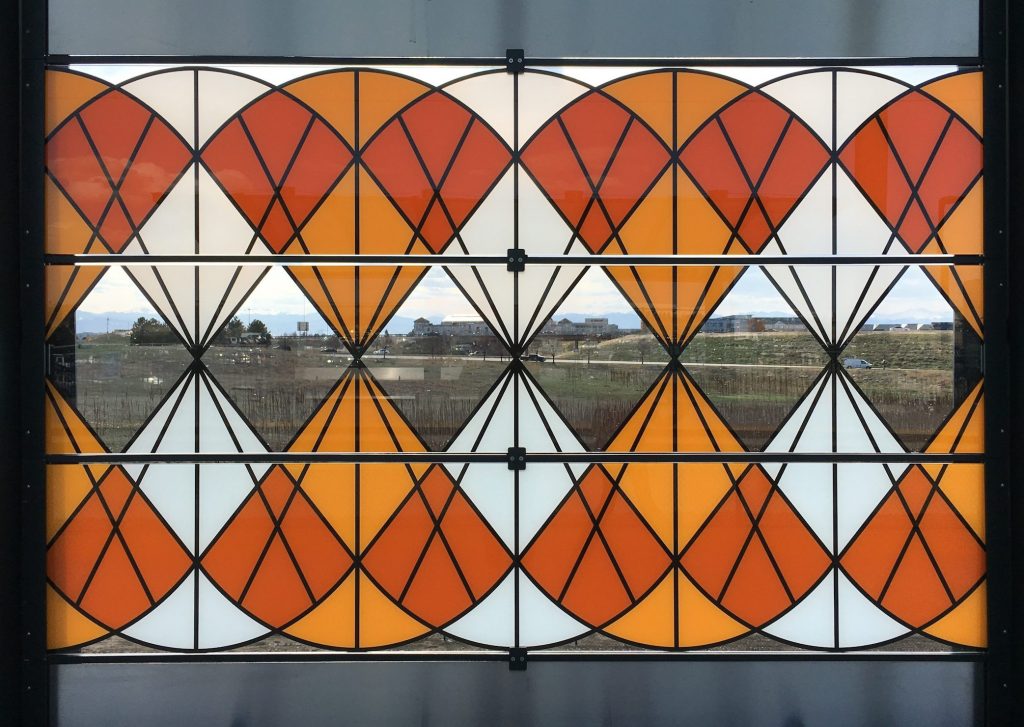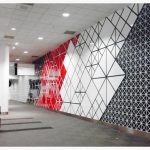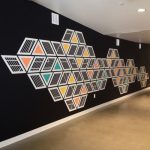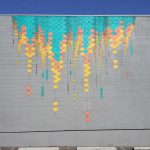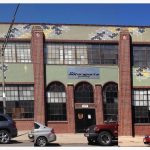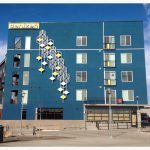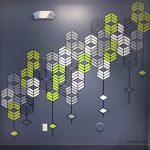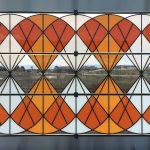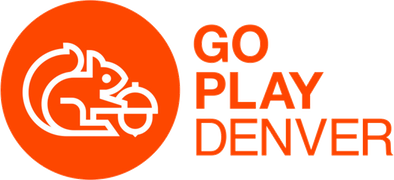Sandra Fettingis – @sandrafettingis
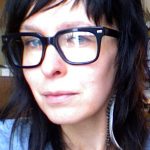
Website: sfettingis.com
Tell me about painting your first mural.
My first mural was in Chicago. I was living here in Denver, but I flew back. It was the summer of 2007 and I remember that I applied for this opportunity and then I got it, but I don’t think it really hit me until I was sitting on the plane, looking at my design on my computer, and then I was like, how am I going to do this? What have I gotten myself into? But I figured it out, and it was, hands down, one of my favorite things I’ve ever done.
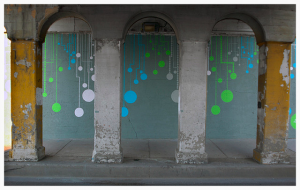
Sandra’s first mural. Chicago, 2007
To make the mural, I spent a week out there under this really dirty, old bridge, painting this piece that was like 30 feet wide by 15 feet high. I had my friends bringing me ladders so I could reach the top of the mural, but I’m kind of afraid of heights, so that was a challenge. Even though there were some challenges, it was really fun to have my friends there to help me, and getting to interact with the public as well. I remember that this kid walked by with his mom and he asked me, “Can we take a picture with you?” I was like, of course, that’s really sweet. I’m like nobody and this is like nothing, but they were really excited about it. They thanked me for doing the piece and for adding it to the neighborhood.
That first mural made me fall in love with the act of making public art. I had always loved seeing public art and street art, but actually getting my hands into it? I was really sad when the mural was done. I had spent a week under this bridge and I was really sad to leave. I didn’t expect that.
In general, what’s your process for creating a mural?
My process is pretty long. I start with concepting, which definitely takes me a while. I want to make sure the design is right for the space and the audience and the community. Then there’s a back-and-forth with the client to make sure that they’re happy. After that, I have to create either stencils or a layout and figure out all my measurements. And all of that is happening in Illustrator on my computer. I’m not really a pen-to-paper person, I mean sometimes, that’s how things happen, but everything is usually on the computer.
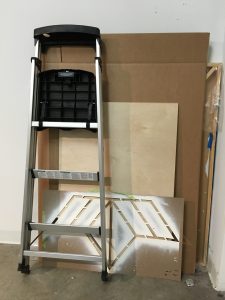
Some of Sandra’s tools against the wall of her studio at Redline.
So, I’m creating the layout, checking all my dimensions, making sure everything is going to fit perfectly, and even coming back to the site and remeasuring because there’s nothing worse that getting your measurements wrong. When you’re working big, inches don’t necessarily matter, but with my stuff, actually it does, because everything is supposed to line up perfectly, so maybe 1/2 an inch is okay, but if I’m off and inch or two, it messes the whole thing up. There’s a lot of double checking and triple checking.
Then I order my chipboard stencils from a laser cutting shop after designing them on the computer and I get my paint. I figure out what I’m going to need in terms of ladders or lifts or assistants, look at how many days I’m going to need and what the weather is going to be like. And then I actually get on site. When I’m on site, I try to paint for long periods of time because your out there, so you might as well. When I was creating my piece at the convention center, I was out there like ten 12-hour days. I usually only paint during the day unless there’s a time crunch. I don’t like painting with lights because there are always shadows and then I can’t see; it really messes me up. You also can’t see the colors or tell if you’ve put enough paint down.
One of my favorite parts about working publicly is working with the existing architecture and figuring out how a piece is going to feel seamless in an environment.
In terms of marking out my design, it really depends on the wall, whether it’s rough or smooth, and its color. I’ll often just use what’s on hand so I’m not buying new materials because I know it’s just going to be wiped away. On Larimer and 27th, the wall was so rough that it was just tearing through my pencils, so it was me and one assistant holding the stencil and drawing the lines as quickly as we could so we would know where the perimeter was in order to do the fill, and then handing our pencils back to our other assistants who would just be there sharpening the pencils. Every wall is different. I use acrylic plastic, latex, acrylic, spray paint, glass and styrene in my work.
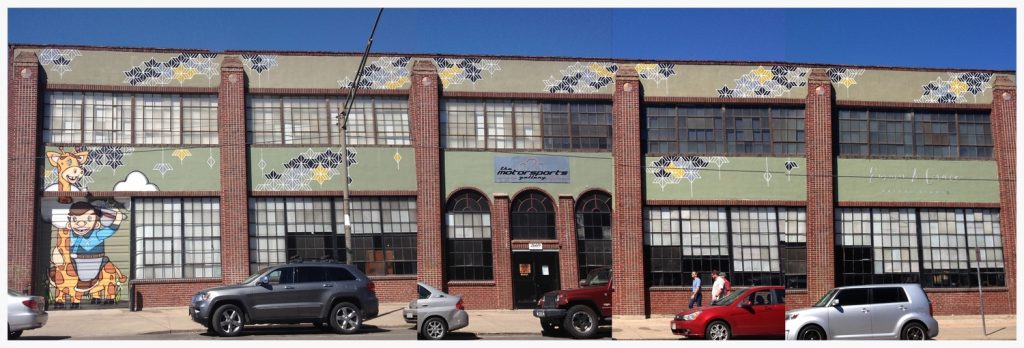
Sandra’s Colorado Crush Mural in collaboration with Mike Graves – 27th & Larimer.
What do you think is the role of art in the public space?
Everyone seems to want a mural on their building. And I can see why, as it becomes a sort of attractor; it creates a landmark. People might ask a friend, “hey where should I meet you?” and they might say “by that black and white mural.” It’s a kind of place making. Also, it beautifies the city and creates a uniqueness and a layer of interest. Public art can separate one city from another or even just one neighborhood from another.
Another thing that I’ve learned, is that where there is public art, people take care of the area more. This could be anti-graffiti campaigns or simply caring for the artwork in order to preserve it.
Who has been the biggest influence on you?
In Chicago, a lot of my art friends were doing work outside and when I got to know them and understand their process, it all started to feel right to me. I feel like my work fits better outside than in a gallery. So meeting a lot of those people and seeing public work and street art in Chicago certainly influenced me.
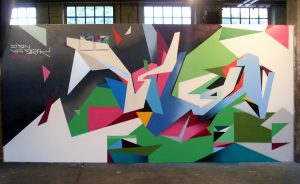
An example of graffuturism by German-born artist Till Heim, who also goes by the name “Sign”
As far as current influencers, there are a lot of people who work under the umbrella of graffuturism. It’s a lot of European street artists who are doing more minimal work outside. It’s really bold shapes with a couple of lines and I’m like dying over that work. For me, that’s another thing that keeps me going, that there are other people like me who are in that same vein. It makes me feel like I’m not such an outsider, like I’m not alone on this.
When you make public work, you have to accept that there going to be a lot of opinions about your work; and that it might be painted over, the building might be knocked down or your artwork might be removed. So many things might happen, so as a public artist, you have to accept this impermanence of things.
If you could put your artwork on any space in the city, where would that be?
I feel really lucky about where I’ve been able to put my artwork so far. I’ve been able to put my work is in a variety of different places and in a number of neighborhoods…. Well, now that you bring up the Cherry Creek bike path… I just got my first car a year ago and before that I rode my bike everywhere. Cherry Creek was a huge part of that as I was heading back and forth from the MCA to Baker. When I first moved here, I thought, look at all these walls! Why aren’t there murals down here?! This is crazy! There are miles of walls! And now, it’s finally happening and it’s awesome. I would be so honored to be able to put a piece down there.
What’s something you think passersby might not notice about your work at first glance?
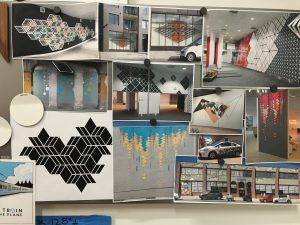
The magnet board above Sandra’s desk at her studio at Redline.
All of my work is very personal in an abstract way. I’m interested in the idea of change and how it’s a very hard thing, but also this very consistent thing in our lives, so in one way or another, most of my work is pointing at that, very quietly because it’s super abstract, but it’s there. I haven’t really tucked anything in visually, it’s more metaphoric.
What does the future hold for you in terms of your art?
I’m going to be painting a mural on the 34 Degrees Crackers headquarters, across from Crema. I’m starting that in May, just after Mother’s Day. I’m doing an indoor piece for this company downtown called M.E. Group and I’m also working with The Stanley on a piece. In September, I’ll do a piece at the Atlas Institute on the CU campus. Oh! And there’s a “Women in Abstraction” show at the CVA this summer and I’ll be painting outside.
What does summertime in Denver mean to you?
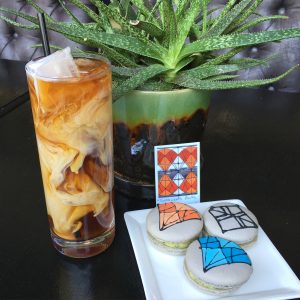
Painted macarons inspired by Sandra’s artwork will be available at Black Eye Cap Hill 5/4 – 5/10.
Summertime means long days and all the things you can do in a day. Now that I live in Denver, I love going up to the mountains and hiking and taking advantage of all that the mountains have to offer. There are also a lot of great patios here where you can just sit out. The city really comes alive in summer as people go outside. On a very small level, I love just opening up my windows when I’m working at home. I love just being at my house barefoot, in shorts and a tank top, windows open, curtains blowing in the breeze… I just love the feel of summer.
What do you usually order at a coffee shop?
I’m just a straight up coffee girl. I like a dark roast, not a light roast. I eat pretty paleo, so I don’t get any pastries, just coffee with cream, dark roast.
Go see the art! Here’s where to find some of Sandra’s works:
- “I Know That You Know That I Know” – Colorado Convention Center
- “The Writing on the Wall” at Galvanize – 1644 Platte St.
- Exterior mural at Redline – 23rd & Arapahoe
- Colorado Crush Mural – 27th &
- Denizen – 415 S. Cherokee St
- Interior mural at Denizen – 415 S Cherokee St
- “Tumbleweeds Really Do Exist,” 1 of 5 installations along the A Line route
